The break apart subtraction strategy is a great 2-digit subtraction strategy to teach 2nd grade students because it has them being flexible with the numbers. They work with the numbers in a way that makes it easier to subtract.
Why is it called the break apart strategy? It’s because they break apart the number they are subtracting. Since they are making easier numbers to subtract, when students get enough practice with the break apart subtraction strategy, they are able to use it as a mental strategy.
This strategy can be a bit tricky for 2nd grade students at first, but I’ve found that when I help students see the patterns used in this break apart strategy for subtraction they can find success!
I have a free guide that outlines all the patterns and common mistakes for each of the 2-digit addition and subtraction strategies. Grab your free copy here: The Ultimate Teaching Guide for 2-Digit Addition & Subtraction Strategies
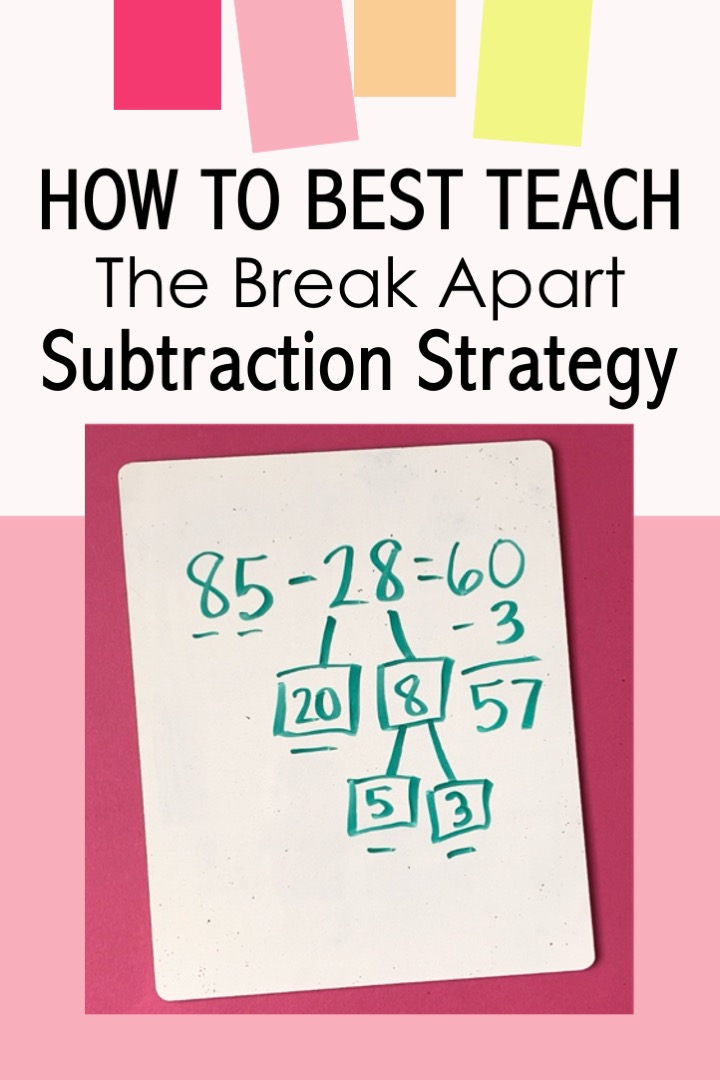
I’m sharing my best tips for how to teach the break apart subtraction strategy to 2nd grade students.
So in this blog post, I’m going to do a deep dive into what this subtraction strategy looks like along with the best way to teach break apart to subtract using 2-digit numbers.
But first… If you’re a parent who has a child struggling with math, you’ve got to check out Learner. Learner is an online tutoring platform that sets students up for success. To get started take a short quiz about your child’s needs. Then Learner’s Success Management Team reviews that and matches your child with the perfect tutor. Get your $25 trial here.
Break Apart Subtraction Strategy
When explaining to you how the break apart strategy for subtraction works, let’s look at an example. Let’s use the equation 85-28.
We are going to break apart the number we are subtracting. First, we break it apart into tens and ones. I like to draw boxes underneath the number to show this. There is a box for the tens and a box for the ones. We break apart 28 into 20 and 8. The 8 also needs to be broken apart. But there are many ways to break apart 8. How should we break it apart for the break apart subtraction strategy?
To break apart the 8, we look at the number we are taking away from, 85. We actually look at the ones number in 85. It is 5. So we want to break apart 8 into 5 and 3. I do this with boxes as well, underneath the 8.
Now it is the time to subtract. I like to write 3 equations to do this. We start with 85 and subtract the tens number. 85-20=65. Then we subtract 5. 65-5=60. This gets us down to an even tens number of 60 which will make it easier to subtract our last number 3. 60-3=57. So the answer to 85 minus 28 is 57.
And that’s how the break apart subtraction strategy works. But like I said before, helping students see and use patterns within this strategy brings the most success. So let’s get into how to best teach the break apart strategy for subtraction.
How to Teach Break Apart Strategy For Subtraction
To help students find the most success, I like to teach this strategy in a very scaffolded way. I first have students practice solving subtraction equations where we have a 2-digit number minus a 1-digit number, like 42-7. To help students learn the needed patterns, I also have them first learn by using a hundreds chart.
I use display pages that have examples and a hundreds chart we can all use together. I just display these pages up using our projector. They guide me with examples and help me know what to say. These make teaching the break apart subtraction strategy easy!
I model to students how we break apart that second number by looking at the ones number in the first number. For the example of 42-7, we would break apart 7 into 2 and 5. I also model subtracting 2 and 5 from 42 using the hundreds chart.
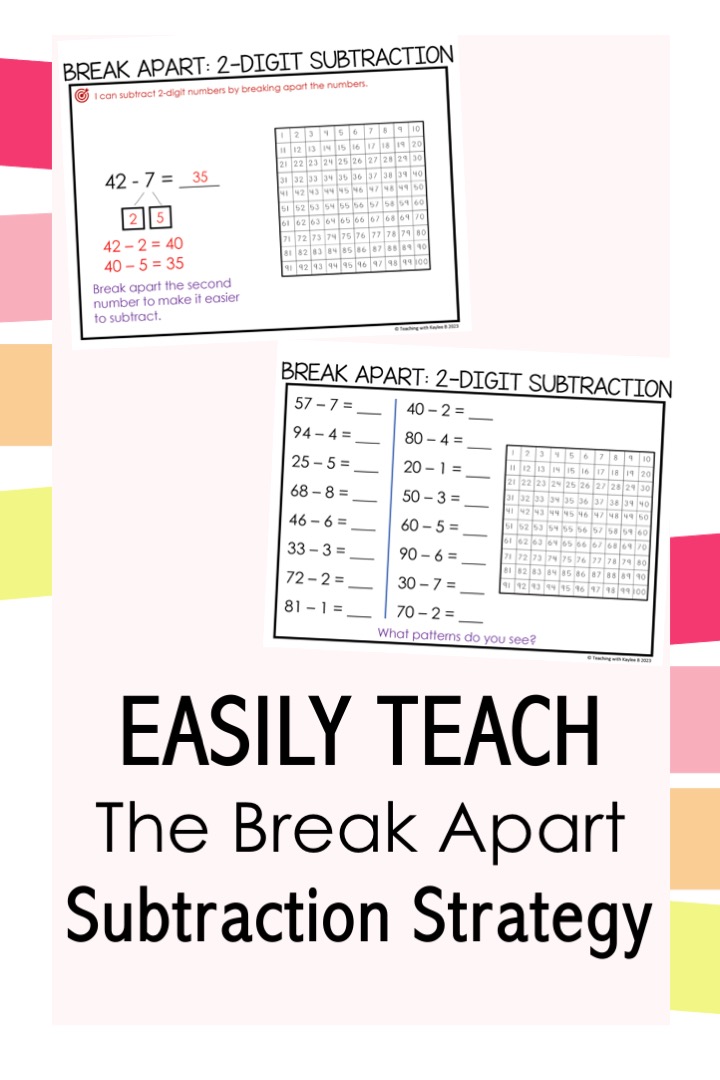
This displays pages guide you on how to teach the break apart subtraction strategy.
But here’s the thing… Students won’t always have a hundreds chart with them. That’s why it’s important to help students discover and use patterns. The next display page I use has a bunch of equations. These help students learn that when we have a 2-digit number minus a 1-digit number that is the same as the ones number in the 2-digit number, it gets us down to the next even tens number. These equations are like 57-7, 94-4, 25-5.
I have students solve these equations using the hundreds chart. Then I simply ask them, “what patterns do you see?” Students see that it gets them down to the next even tens number. 57-7=50, 94-4=90, 25-5-20. Now they can do this step without using a hundreds chart.
I do this same process with equations where we have an even tens number minus a single digit number. These are equations like 40-2, 80-4, 20-1. Students solve these on the hundreds chart. Then I simply ask them, “What patterns do you see?” They see that it’s like subtracting these numbers from 10, they just have a tens number that is one less than the original number. So 40-2=38, 80-4=76, 20-1=19. Now students can solve equations like this without using a hundreds chart. Students do better when they know all the ways to make ten. Learn more about teaching that in this blog post here: Why Math Facts of 10 Are So Important For Students to Learn
Using the display pages, we do some practice problems together using the break apart subtraction strategy. Then students are ready to get practice by themselves. I have them complete a worksheet that has the break apart boxes for them. That way they can remember how to break apart the second number. Then they write the equations underneath to get their answer.
As students are working on this break apart subtraction worksheet, I am walking around monitoring and supporting students. I take a mental note of common mistakes and misconceptions. When students are just about finished with that worksheet, I’ll call their attention and address those common mistakes and misconceptions. I may do a few more example problems as a class to help students find more understanding.
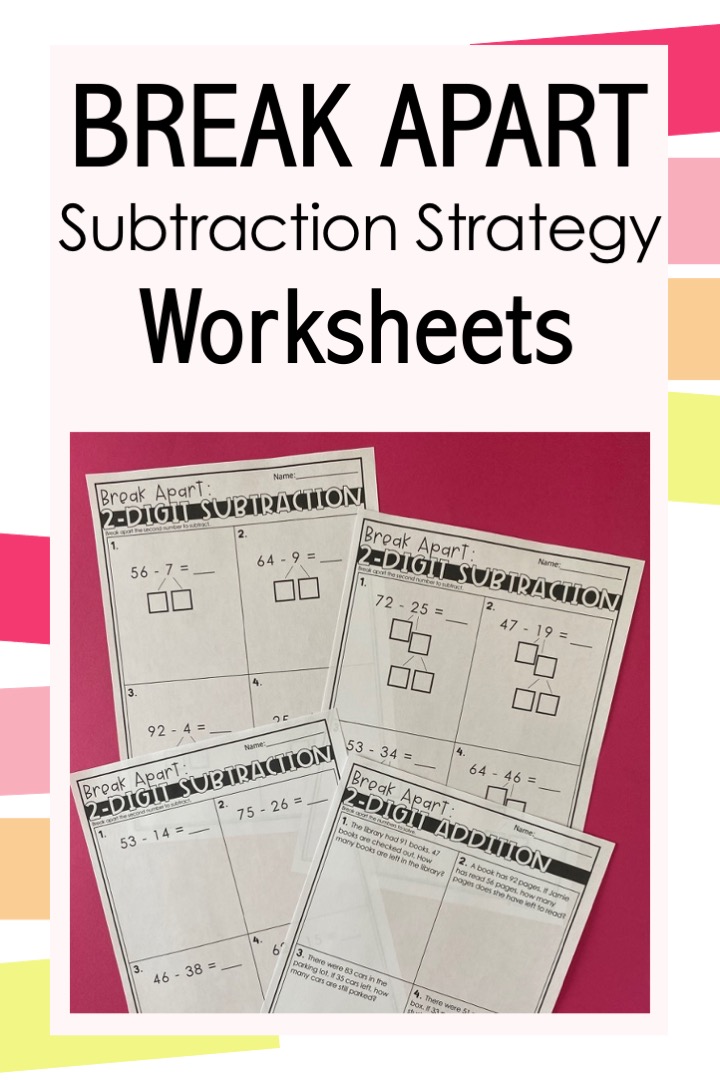
Scaffolded worksheets help students find success with the break apart strategy for subtraction.
Then I’ll give them a break apart subtraction worksheet to work on by themselves. I wait at our classroom table with a smelly marker. As students finish that worksheet, they come line up by my table. I do a quick check looking through their work and helping them fix any mistakes. Then I give a big check mark on their page. They then put it in their Take Home Folder. I love how setting up the independent practice part of the lesson in this way gives students immediate feedback. Parents are also able to see how their child did with the lesson that day.
And that is day one of teaching the break apart subtraction strategy. The next day we do a lesson on using break apart to subtract two 2-digit numbers. Here’s how I do that lesson.
Break Apart Strategy For Subtraction
I set this lesson up in a similar way. The display pages guide me with equations and examples to use. These also help me build on the lesson we had the day prior. We now just add subtracting tens into it.
I first teach my students subtracting an even tens number from a 2-digit number. These are equations like 57-20, 94-40, 25-10. Students solve these on the hundreds chart. Then I ask, “What patterns do you see?” Students can see that the tens number goes down by that many tens. So 57-20=37, 94-40=54, 25-10=15. Students can now solve these using patterns. They don’t need the hundreds chart anymore.
Then we do a few practice problems together using the break apart strategy for subtraction. We break apart the second number into tens and ones.Then we break apart the ones number so that it matches the ones number in the first number of the equation. After that, we write the three equations below to get our answer.
Now students are ready to get guided practice. To do this, I have them complete a worksheet as I am walking around giving support. I take a mental note of common mistakes and misconceptions. After a bit, I get students’ attention and we go over those things. We may even do a couple problems from the worksheet together to help model these.
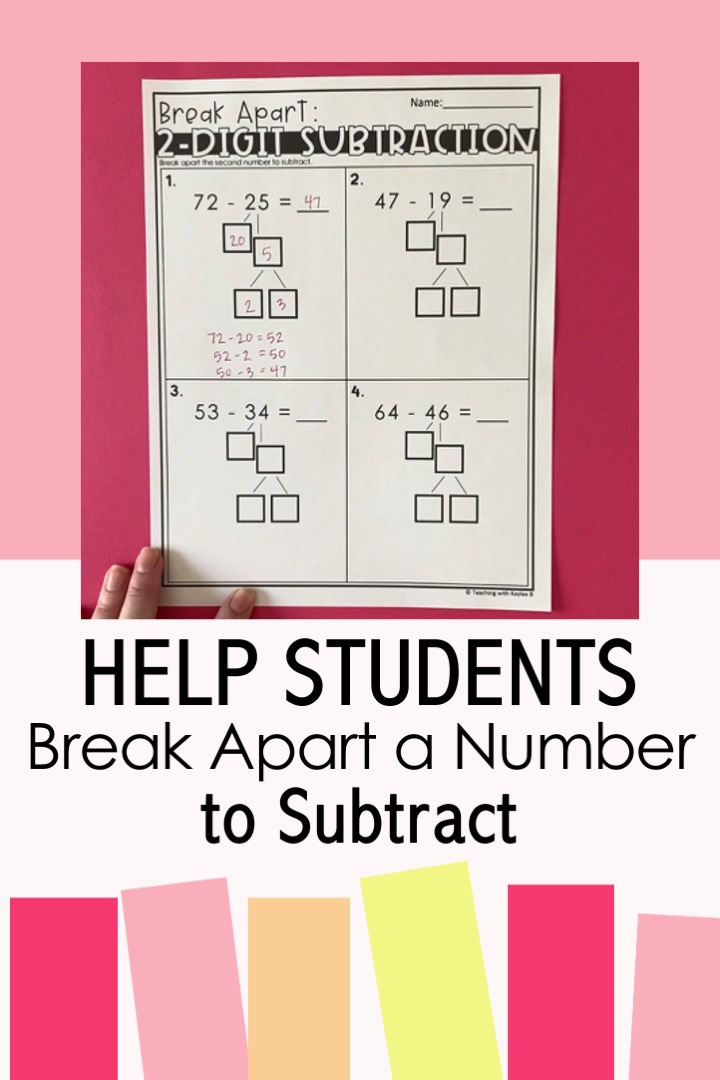
These worksheets guide students so they can break apart a number to subtract.
Then it’s time for independent practice. I have students complete another break apart subtraction worksheet. When students are finished, they line up at our classroom table. I use a smelly marker to review their work and help them fix any mistakes. If everything is fixed and looking good, I give them a big check mark with the smelly marker. Students put it in their Take Home Folder so parents can see how they are doing with this strategy.
After that, I want students to get even more practice with the break spark strategy for subtraction, so I have them complete a scoot activity with a partner. I have task cards taped up around the room with different break apart subtraction problems. Students go around with a recording sheet and solve the problems. This recording sheet is scaffolded because they have the boxes for students to break apart the number.
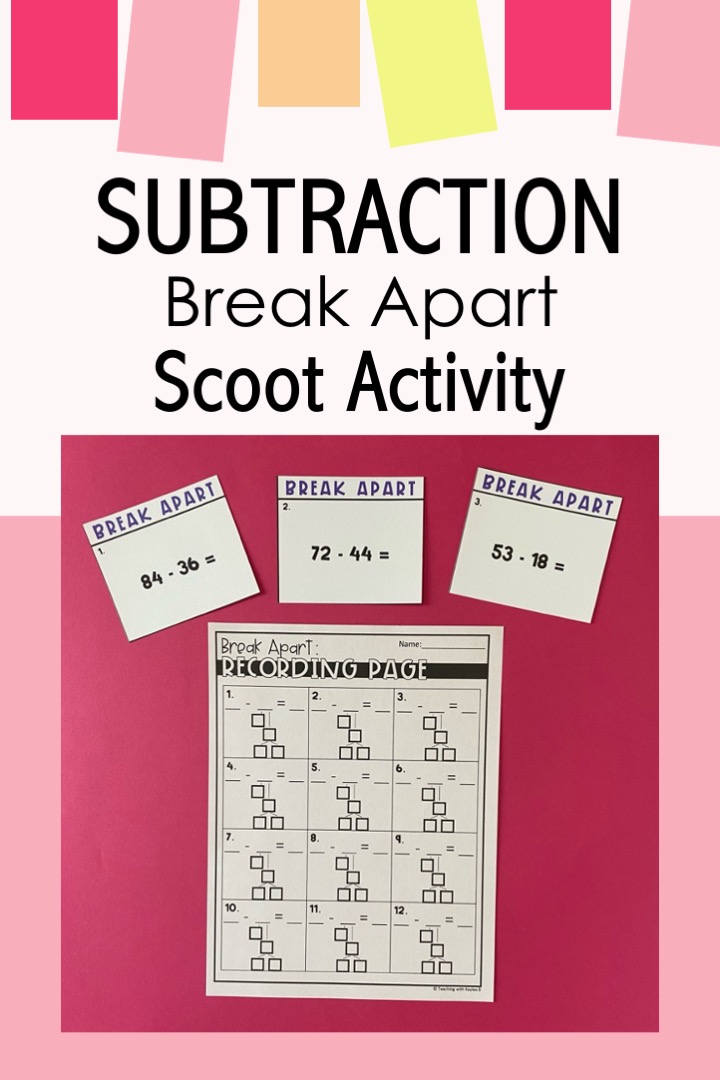
Help students practice the break apart method for subtraction with this fun scoot activity.
I like students to work with a partner to do this scoot activity because they give each other support. It also gets them talking outloud about the process of the strategy, helping them master it even faster.
After students are done, they check their work with an answer key I have set out. I have students use a red pen to fix mistakes and then put their page in their Take Home Folder. That way parents can again see their progress.
I want students to really master this strategy, so I have them complete a fun, hands-on subtraction break apart puzzle. The puzzle has pages of the steps involved in the break apart subtraction strategy. I cut them apart and students put them back together.
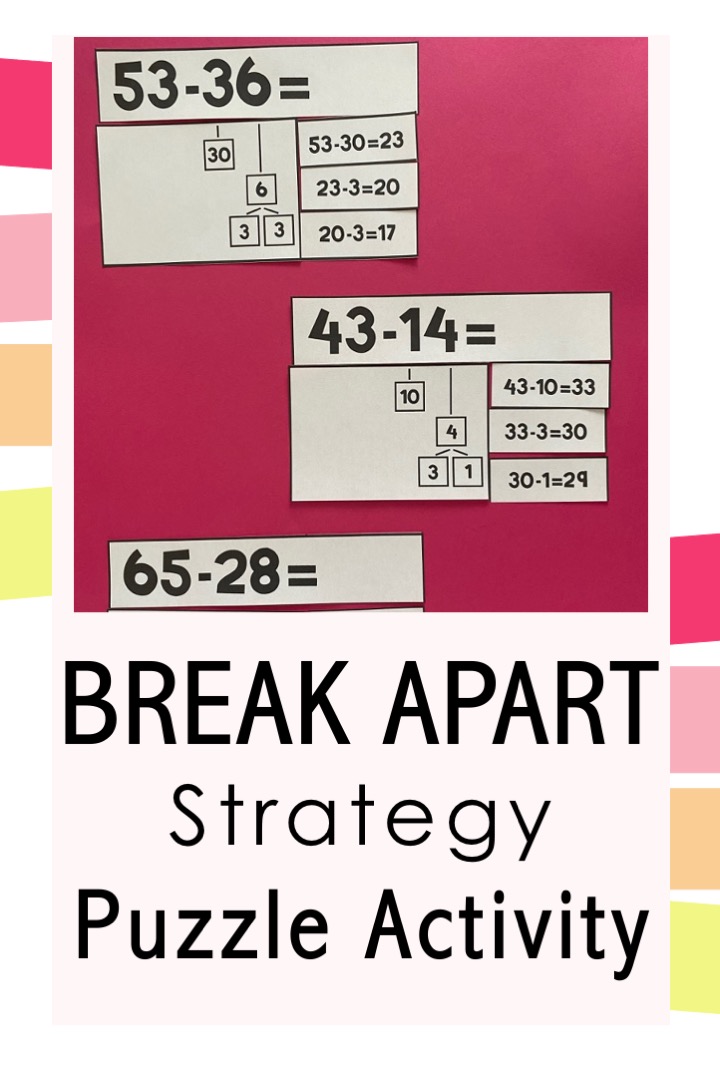
Students find the most success with the 2-digit subtraction break apart strategy when they get lots of practice. This break apart subtraction puzzle is a fun practice activity for students!
Students do well with working with a partner for this activity. They can support each other and it gets them talking outloud about the math. As I am walking around monitoring students, I hear things like “We have to subtract the tens first! We need to find the equation 62-20=42!” When students have their puzzle complete, they raise their hands and I do a quick look over their work. Then students mix up the pieces, stack them up, and they are ready for the next set of students.
Finally, I want to see where each individual student is at with this strategy. So I have them complete an exit ticket. They rate themselves on how they think they understand it. Then they complete a couple problems. After school I’ll quickly take note of who needs a little more practice. I’ll use my other break apart subtraction worksheets and activities to get them more practice during centers.
When students get enough practice with this strategy, they can use it mentally. If you want this to be the case, I would suggest having one more lesson on it. This time use worksheets that don’t have the break apart boxes. Students have to break apart the numbers mentally. Then they use the patterns they used prior to subtract. Find the worksheets I use for this here.
And that’s how I teach the break apart subtraction strategy! It all comes down to scaffolding your lessons into bite-sized pieces, helping students use patterns, and giving students plenty of practice.
Find all of the resources I use to teach the break apart strategy for subtraction here.
You can find this in a money-saving bundle with all of my 2-digit addition and subtraction strategies here.
Learn more about all the 2-digit subtraction strategies I teach in this blog post here: How to Teach Those Tricky 2-Digit Subtraction Strategies
You can learn more about the 2-digit addition strategies I teach my students in this blog post here: 2-Digit Addition Strategies That Work
For 3-digit subtraction, there is a break apart strategy that I teach my students as a metal strategy. Learn more about it in this blog post here.
As an Amazon Associate I earn from qualifying purchases.


